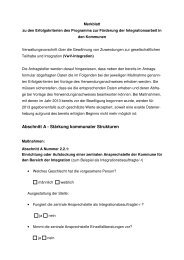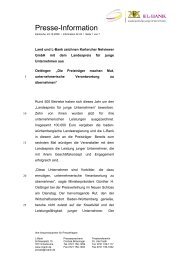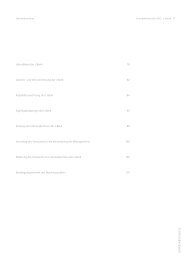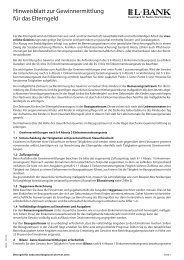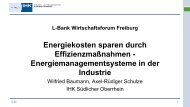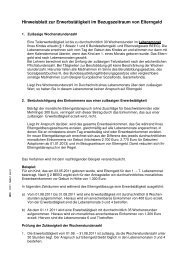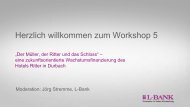Landeskreditbank Baden-Württemberg - L-Bank
Landeskreditbank Baden-Württemberg - L-Bank
Landeskreditbank Baden-Württemberg - L-Bank
You also want an ePaper? Increase the reach of your titles
YUMPU automatically turns print PDFs into web optimized ePapers that Google loves.
Industrial Structure<br />
General Position of Industry<br />
The largest share of the gross value added to the GDP of <strong>Baden</strong>-Württemberg is attributable to services and<br />
other activities and to manufacturing. Commerce and transportation, like agriculture and forestry, are of less<br />
significance.<br />
The following table shows the gross value added in current prices to the GDP of <strong>Baden</strong>-Württemberg during<br />
each of the years indicated:<br />
Gross Value Added in <strong>Baden</strong>-Württemberg*<br />
2003 2002 2001 2000 1999<br />
(in %)<br />
Attributable to: ...................................................<br />
Manufacturing ............................................... 37.3 37.7 38.3 38.7 38.2<br />
Agriculture and forestry ........................................ 0.8 0.8 0.9 1.0 1.0<br />
Commerce and transportation ................................... 15.8 15.8 15.8 15.2 14.7<br />
Services and other activities ..................................... 46.1 45.7 44.9 45.0 46.2<br />
* Date of computation: August 2003/February 2004.<br />
Source: State Statistical Office <strong>Baden</strong>-Württemberg and own calculations, data on economy and prices,<br />
available at www.statistik.baden-wuerttemberg.de/Veroeffentl/Statistische_Berichte/Sachgeb.asp?P,<br />
PDF 4151 03001.<br />
Branches of Industry<br />
The branches of industry with the greatest significance in <strong>Baden</strong>-Württemberg are the machinery, electrical<br />
engineering and automotive industries. Of somewhat less importance are the chemical industry and the textile<br />
and garment industries. Together with the metalworking industries, these six branches employ about three<br />
quarters of the persons employed in industrial enterprises in <strong>Baden</strong>-Württemberg.<br />
From a geographic perspective, <strong>Baden</strong>-Württemberg’s industrial structure is evenly spread throughout its<br />
territory. In addition to the industrial center in the central Neckar area around Stuttgart, there are a number of<br />
other industrial centers, including Mannheim, Karlsruhe, Ulm, Heilbronn and Villingen-Schwennigen. The<br />
primarily rural, less densely-populated areas of <strong>Baden</strong>-Württemberg are also for the most part well supplied with<br />
industrial enterprises. The small and medium-sized (SME) component of the economy of <strong>Baden</strong>-Württemberg is<br />
particularly pronounced.<br />
Tourism<br />
<strong>Baden</strong>-Württemberg has numerous bathing resorts and is one of the most significant states for spas in<br />
Germany. The city of Heidelberg, home of the oldest university in Germany, and other well known tourist<br />
destinations, such as the Black Forest and Lake Constance, attract many German and foreign tourists. <strong>Baden</strong>-<br />
Württemberg is one of the states with the largest amount of tourist traffic in Germany.<br />
Prices and Wages<br />
Prices in Germany generally have been stable. In 2003, prices increased by 1.1%, and in 2002 by 1.4%.<br />
Since January 1, 1999, the European Central <strong>Bank</strong> (ECB) has assumed the task of conducting the single<br />
monetary policy for the Euro-zone, having a free hand to maintain price and currency stability in the Euro-zone.<br />
Before 1999, monetary policy in Germany was conducted by the Deutsche Bundesbank, which served as a model<br />
for the ECB in respect of its independence from political influence.<br />
51



